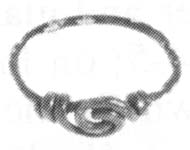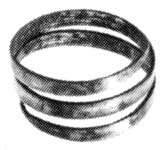 |
||||||
|
Lesson #5: Page 8
Other types include large slip-knot
types, those with ends twisted into a spiral, cast annular and penannular
rings, and annular bands. Most are of copper-alloy, although
some are of silver. There are also a few examples of bead bracelets.
Finger Rings
A considerable measure of continuity from the Roman period is recognized in the types of Anglo-Saxon rings known. Romano-British (and indeed earlier) progenitors can be found for the common spiral rings, which are generally of the fifth- or sixth-century; at present, it seems impossible to separate those of contemporary manufacture from earlier (Roman period) rings, worn by the later generations of Anglo-Saxon women. These spiral rings may have terminals which barely overlap or they may be carried around the finger two or three turns. This type of ring (along with simple, penannular types) are often termed ‘expanding rings’, a term which acknowledges the advantages of their variable diameter; they are also easily made – or indeed re-made – from scrap metal, a factor which no doubt contributed to their popularity. Also Romano-British in inspiration, if not in origin, are a series of annular rings with expanded bezels. These might be of copper-alloy or silver, or in some instances of gold. Some may have been set with enamel, whilst a few are set with Roman glass intaglios. They generally date to the fifth century. Others with spiral-twisted bezels, are characteristically sixth- or seventh-century in date: it has been suggested that these may have had an amuletic as well as decorative function, serving to deflect the Evil Eye by their convoluted forms. Closed bands of silver or copper-alloy, plain or with grooved or stamped ornament, may also be assigned to the fifth or sixth century, although some, particularly those with octagonal outlines, again betray Romano-British inspiration. click on image for larger version in new window
Spangles
Meaney comments on their occurrence on necklaces or festoons of beads; she suggests they may have been worn as ornaments in the hair and that their diverting appearance and sound may have served to deflect the malevolent powers of the Evil Eye. Some, she further suggests, may have ornamented amulet bags. They are of thin sheet metal, usually bronze and are decorated by perforation, stamping, and punching raised bosses. They are usually square, diamond, triangular or trapezoidal in shape, although a few circular examples are also known.
|
||||||
| Costume
Classroom is a division of The
Costume Gallery, copyright 1997-2001.
Having problems with this webpage contact: questions@costumeclassroom.com |
||||||



